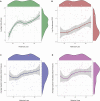Historical Loss: Implications for Health of American Indians in the Blackfeet Community
- PMID: 33969868
- PMCID: PMC8832106
- DOI: 10.1093/abm/kaab032
Historical Loss: Implications for Health of American Indians in the Blackfeet Community
Abstract
Background: Historical loss in American Indians (AIs) is believed to contribute to high incidence of mental health disorders, yet less is known about the associations between historical loss and physical health.
Purpose: To investigate whether frequency of thought about historical loss predicts risk factors for chronic physical health conditions in an AI community.
Methods: Using Community Based Participatory research (CBPR) and Ecological Momentary Assessment (EMA), we measured frequency of thoughts about historical loss in 100 AI adults residing on the Blackfeet reservation. Participants completed a 1-week monitoring period, during which ambulatory blood pressure and daily levels of psychological stress were measured. At the end of the week, we collected a dried blood spot sample for measurement of C-reactive protein (CRP).
Results: In hierarchical linear regression models controlling for demographics and relevant covariates, greater frequency of thoughts about historical loss predicted higher average daily psychological stress (B = .55, t = 6.47, p < .001, ΔR2 = .30) and higher levels of CRP (B = .33, t = 3.93, p < .001, ΔR2 = .10). Using linear mixed modeling with relevant covariates, we found that greater thoughts about historical loss were associated with higher systolic ambulatory blood pressure (B = .32, 95% CI = .22-.42, t = 6.48, p < .001, ΔR2 = .25; Fig. 1c) and greater diastolic ambulatory blood pressure (B = .19, 95% CI = .11-.27, t = 4.73, p < .001, ΔR2 = .19).
Conclusions: The data suggest that frequency of thought about historical loss may contribute to increased subclinical risk for cardiovascular disease in the Blackfeet community.
Keywords: Ambulatory blood pressure; American Indians; Historical loss; Inflammation; Psychological stress ∙ Ecological Momentary Assessment.
© Society of Behavioral Medicine 2021. All rights reserved. For permissions, please e-mail: journals.permissions@oup.com.
Figures

Similar articles
-
Historical loss: Implications for physical activity levels in American Indian adults.J Rural Health. 2023 Mar;39(2):367-373. doi: 10.1111/jrh.12673. Epub 2022 May 4. J Rural Health. 2023. PMID: 35508763 Free PMC article.
-
Loneliness and sleep in the American Indian Blackfeet community.Sleep Health. 2021 Aug;7(4):429-435. doi: 10.1016/j.sleh.2021.04.005. Epub 2021 Jul 1. Sleep Health. 2021. PMID: 34217696 Free PMC article.
-
Emotion Regulation Strategies Relate to Ambulatory Cardiovascular Activity in an American Indian Community.Psychosom Med. 2023 Jan 1;85(1):2-7. doi: 10.1097/PSY.0000000000001140. Epub 2022 Oct 13. Psychosom Med. 2023. PMID: 36516315 Free PMC article.
-
Historical trauma and social support as predictors of psychological stress responses in American Indian adults during the COVID-19 pandemic.J Psychosom Res. 2020 Dec;139:110263. doi: 10.1016/j.jpsychores.2020.110263. Epub 2020 Oct 2. J Psychosom Res. 2020. PMID: 33038816 Free PMC article.
-
Historical Trauma, Ethnic Experience, and Mental Health in a Sample of Urban American Indians.J Am Psychiatr Nurses Assoc. 2020 Mar/Apr;26(2):145-156. doi: 10.1177/1078390319888266. Epub 2019 Nov 21. J Am Psychiatr Nurses Assoc. 2020. PMID: 31747831
Cited by
-
Profiles of historical loss and childhood trauma as predictors of mental and cardiometabolic health in American Indian adults.SSM Ment Health. 2023 Dec 15;4:100252. doi: 10.1016/j.ssmmh.2023.100252. Epub 2023 Jul 31. SSM Ment Health. 2023. PMID: 38188870 Free PMC article.
-
Spirituality, loneliness and mental health in Blackfeet American Indian adults.PLoS One. 2025 Jun 13;20(6):e0325931. doi: 10.1371/journal.pone.0325931. eCollection 2025. PLoS One. 2025. PMID: 40512758 Free PMC article.
-
Investigating psychosocial factors and systemic inflammation using dried blood spots: a scoping review.Soc Psychiatry Psychiatr Epidemiol. 2025 Jun 13. doi: 10.1007/s00127-025-02941-0. Online ahead of print. Soc Psychiatry Psychiatr Epidemiol. 2025. PMID: 40514590 Review.
-
Association between gene methylation and experiences of historical trauma in Alaska Native peoples.Int J Equity Health. 2023 Sep 8;22(1):182. doi: 10.1186/s12939-023-01967-7. Int J Equity Health. 2023. PMID: 37679827 Free PMC article.
-
Canada's Colonial Genocide of Indigenous Peoples: A Review of the Psychosocial and Neurobiological Processes Linking Trauma and Intergenerational Outcomes.Int J Environ Res Public Health. 2022 May 26;19(11):6455. doi: 10.3390/ijerph19116455. Int J Environ Res Public Health. 2022. PMID: 35682038 Free PMC article. Review.
References
-
- Paradies Y. A systematic review of empirical research on self-reported racism and health. Int J Epidemiol. 2006;35: 888–901. - PubMed
Publication types
MeSH terms
Grants and funding
LinkOut - more resources
Full Text Sources
Other Literature Sources
Research Materials
Miscellaneous

